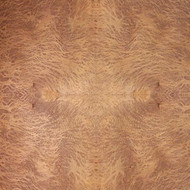Redwood Burl wood comes from the burl formations of the Redwood tree (Sequoia sempervirens), one of the most iconic and long-lived tree species found on the Pacific Coast of the United States, primarily in California. Burl wood is the result of irregular growths on the tree, often caused by environmental stress, disease, or injury. Redwood Burl is highly prized for its stunning grain patterns and rich, warm colors, making it a favorite for fine woodworking and decorative applications.
Characteristics of Redwood Burl Wood:
- Grain Patterns:
- Redwood Burl is known for its mesmerizing and intricate grain patterns, including swirling, twisting figures, and "eyes" (small, rounded patterns resembling knots).
- These complex patterns make each piece of Redwood Burl unique.
- Color:
- Typically ranges from deep reddish-brown to lighter hues with golden undertones.
- The vibrant color and natural luster enhance its decorative appeal.
- Texture:
- Fine and smooth, allowing for excellent finishing and polishing.
- Can produce a rich, glossy surface with proper treatment.
- Durability:
- Redwood is naturally resistant to decay and insects, although the burl wood itself is softer and less durable than regular straight-grain Redwood.
- Requires careful handling due to its irregular grain, which can make it more prone to splitting or cracking.
- Rarity:
- Redwood burls are relatively rare, and harvesting is strictly regulated to protect these ancient trees and their ecosystems.
Uses of Redwood Burl Wood:
- Furniture and Veneers:
- Commonly used for high-end furniture pieces like tables, cabinets, and decorative panels.
- Veneers from Redwood Burl are especially popular for luxury interiors and architectural details.
- Woodturning:
- Ideal for crafting decorative bowls, vases, and other turned objects that showcase its intricate patterns.
- Luxury Goods:
- Used in crafting high-end pens, knife handles, jewelry boxes, and small decorative items.
- Musical Instruments:
- Applied as a decorative top layer for guitars and other string instruments.
- Artistic Projects:
- Favored by artists and sculptors for creating unique and visually striking art pieces.
Challenges:
- Workability:
- The irregular grain can make Redwood Burl difficult to cut and shape, as it is prone to tear-out and splitting.
- Stabilization or resin infusion may be necessary for pieces with voids or cracks.
- Cost and Sustainability:
- Redwood Burl wood is expensive due to its rarity and high demand.
- Harvesting is heavily regulated to ensure the conservation of Redwood forests, which can limit supply.
Why It's Valued:
Redwood Burl wood is cherished for its unparalleled beauty, combining deep, warm colors with intricate grain patterns that create a sense of luxury and natural elegance. Its rarity and uniqueness make it a prized material for projects that demand individuality and sophistication, ensuring that every piece of Redwood Burl is one of a kind.


